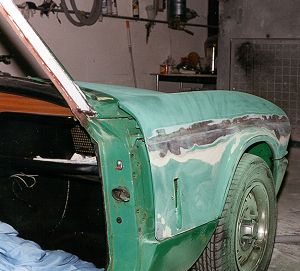
|
|
|
|
|
|
|
|
|
|
|
|
|
|
|
|
|
|
|
|
|
|
|
|
The crash
|
|
|
|
|
|
|
|
Copyright ©2000
by Eric Kieboom
All Rights Reserved

|

|

|
Things that go WHAM!

Dented bonnet, damaged bumper, buckled number plate, broken underrider, shattered indicator lens. Moped was a total loss, its driver luckily survived impact with only minor scratches.
|
According to witnesses, the driver, who was not wearing a crash helmet, was doing at least 30Mph/50Kph at the moment of impact. This type of moped is allowed to do 15Mph/25Kph in this country. Luckily, the driver was not seriously injured, but his bike was a mess and so was my Spitfire's pointy bit.
|
Good insurance pays off
 Tackling minor rust in the bonnet joints. Rusty backs of A-pillars were expertly patched. Doors removed for ease of access.
Tackling minor rust in the bonnet joints. Rusty backs of A-pillars were expertly patched. Doors removed for ease of access.
|
Dented bonnet, dented bumper, broken underrider, shattered indicator lens. Doesn't seem like a lot of damage, but it cost about a quarter of what I originally paid for the car to put it all right.
Luckily, the car is well insured. The insurance company had no problem with me wanting to have the job done at a proper classic car restorer instead of your regular body shop. They agreed with Lubbers that the bonnet needed a complete respray. This gave me the chance of having some other things taken care of.
When I bought the car, there was already some rust in the back of the windscreen pillars and in the bonnet joints. The radio aerial on the left hand windscreen pillar was useless (no radio needed - the engine makes the best music), so it needed removing and the holes welded up. Some bubbling in the right lower corner of the bonnet could also be rectified now.
The backs of the windscreen pillars are known rotspots on Spitfires, as water gets easily trapped behind the door window seals. The windscreen surround is one of the few really unavailable parts at the moment, so repairs need to be handmade. Luckily, the backs of the windscreen pillars are simple flat sheet steel, so this was only a small problem.
To prevent the pillars from rotting again in the near future, they were injected with a generous dose of wax.
 Preparing car for spraying took ages - as it should do. Lots of sanding, filling, more sanding and grounding. In order to get a better colour match between front and back of car, painters decided to also paint doors. No extra charge.
Preparing car for spraying took ages - as it should do. Lots of sanding, filling, more sanding and grounding. In order to get a better colour match between front and back of car, painters decided to also paint doors. No extra charge.
|
New parts for Triumph Spitfires may be comparatively plentiful and easy to get, but I found that the quality varies wildly - especially when it comes to shiny bits. The new front bumper cost an arm and a leg, but was of very mediocre quality. A second, even more expensive example was even worse, with lots of machine scratches showing through the thin chrome. It probably pays to find an old, undented bumper with bad chrome and have it refurbished by a reputable plater. This new bumper will probably have to be replated again in a few years time, since the chrome is very thin.
Underriders of the correct plastic type are no longer available. There was no good used example at hand, so a fibreglass replica was installed. Both the replica and the remaining original underrider were sprayed semi gloss black to prevent colour difference.
For a good paintjob, preparation is everything, so this took a l o n g time. The first result was not to my liking - too many irrergular patches and dust specks. The restorers agreed and resprayed it. Twice. No questions asked.
Spitfire 1500's have a comparatively modern decal saying "Spitfire 1500" on the bonnet. Some people leave them off after a respray, but I think it belongs on the car and had it replaced. For finding the exact location of the decal, the restorers used original sales literature.
The original aluminium windscreen capping was damaged by careless closing of the softtop by previous owners. Now that the capping was removed for spraying anyway, the job was rounded off by installing a new windscreen capping, which Lubbers unintentionally but very cordially did not put on the invoice.
|
 
|